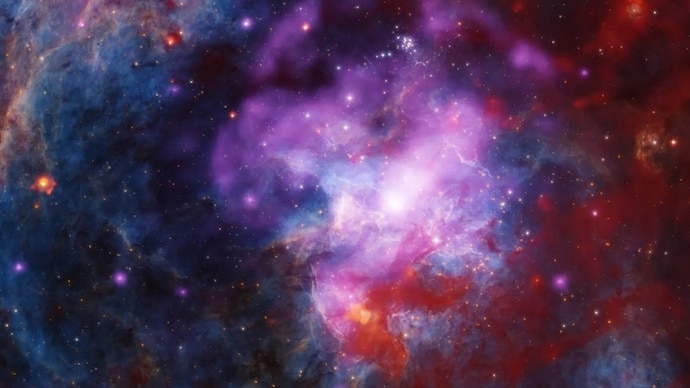Description

Disclaimer: Copyright infringement not intended.
Context
- The Chandra X-ray Observatory, operated by NASA, recently captured a remarkable image of 30 Doradus B, a supernova remnant situated in the Large Magellanic Cloud, located approximately 160,000 light-years away from Earth.
- This image, a composite of various wavelengths of light, showcases the intricate details of 30 Dor B.
Details
What is a Supernova?
- A supernova is a catastrophic event that occurs at the end of a massive star's life cycle.
- It involves a colossal explosion, leading to the sudden brightening of a star, followed by a gradual fading.
- These explosions are immensely powerful, often outshining entire galaxies for a short duration.
Types of Supernovae:
- Type Ia Supernova:
- Occurs in binary star systems where one is a white dwarf and the other is a companion star.
- The white dwarf accretes material from its companion until it reaches a critical mass (Chandrasekhar limit), triggering a runaway nuclear fusion, causing an explosion.
- Type II Supernova:
- Results from the core collapse of massive stars (at least 8 times the mass of the Sun) at the end of their life cycle.
- Core collapse initiates when the star's nuclear fuel is exhausted, leading to a rapid implosion followed by a powerful explosion.

Phases of a Supernova Explosion:
- Collapse:
- Type II: The core of a massive star contracts due to gravity, heating up rapidly.
- Type Ia: The white dwarf's mass reaches the Chandrasekhar limit, leading to a sudden collapse.
- Explosion:
- Type II: The core collapse triggers a shockwave, leading to the expulsion of the star's outer layers.
- Type Ia: The runaway fusion causes the white dwarf to explode completely.
- Peak Brightness:
- Supernovae become incredibly luminous, outshining entire galaxies and briefly becoming one of the brightest objects in the universe.
- Aftermath:
- The remnants of a supernova may include a neutron star, a rapidly rotating pulsar, or in the case of extremely massive stars, a black hole.
Importance of Supernovae:
- Element Formation:
- Supernovae synthesize and disseminate heavy elements (like iron, gold, and uranium) into space, which are crucial for forming planets and life.
- Cosmic Evolution:
- They play a pivotal role in shaping galaxies, dispersing elements, and triggering the formation of new stars and planetary systems.
- Astronomical Tools:
- Supernovae, especially Type Ia, serve as standard candles, helping astronomers measure cosmic distances and study the accelerating expansion of the universe.
Supernova Remnants (SNRs)
- When a massive star reaches the end of its life and explodes in a cataclysmic event known as a supernova, it leaves behind a complex structure called a Supernova Remnant (SNR).
- SNRs are fascinating celestial objects that play a significant role in understanding stellar evolution, element formation, and the dynamics of the interstellar medium.
Formation of Supernova Remnants:
- Supernova Explosion: A massive star ends its life in a powerful explosion, expelling its outer layers into space.
- Shockwave Formation: The explosion generates a powerful shockwave that propagates outward, interacting with the surrounding interstellar medium (ISM). This interaction heats up the material and causes it to glow brightly across different wavelengths of light.
Structure and Characteristics:
- Expanding Shell: The SNR is composed of an expanding shell of gas and dust, propelled by the supernova explosion's energy.
- Stages of Evolution:
- Free Expansion Phase: Initially, the SNR expands freely at high speeds, gradually slowing down as it interacts with surrounding material.
- Sedov-Taylor Phase: As the SNR evolves, the shockwave transitions into the Sedov-Taylor phase, characterized by a shell with a swept-up and compressed ISM.
- Physical Components:
- Shock Front: The leading edge of the expanding shell where the interaction with the ISM occurs.
- Ejecta: Material ejected from the explosion, containing heavy elements synthesized during the supernova.
- Emission Spectra:
- SNRs emit radiation across the electromagnetic spectrum, including radio waves, visible light, X-rays, and gamma rays.
- Observing different wavelengths helps astronomers study various physical processes within SNRs.
Importance:
- Elemental Enrichment:
- SNRs disperse heavy elements (created during the supernova) into the interstellar medium, enriching it with elements crucial for forming new stars and planets.
- Cosmic Ray Acceleration:
- These remnants are believed to be sites where cosmic rays, high-energy particles, are accelerated to near-light speeds.
- Stellar Life Cycle:
- SNRs play a vital role in the life cycle of galaxies, as they provide energy and trigger the formation of new stars.
Notable Supernova Remnants:
- Crab Nebula (M1): One of the most studied SNRs, resulting from a supernova observed in the year 1054 AD.
- Cassiopeia A: Known for its young age and rich diversity of elements observed in its spectra.
About Chandra X-ray Observatory (CXO)
- Initially called the Advanced X-ray Astrophysics Facility (AXAF), it is a flagship-class space telescope launched aboard the Space Shuttle Columbia during STS-93 by NASA on July 23, 1999.
- Chandra operates in the X-ray spectrum, detecting X-ray sources that are nearly 100 times fainter than previously observed.
- This sensitivity is enabled by its high angular resolution mirrors, making it a crucial tool for X-ray astronomy.
Chandra's Mission and Purpose:
- Enhanced Sensitivity: Detects X-rays which are mostly absorbed by the Earth's atmosphere, necessitating space-based observations.
- Part of Great Observatories: Alongside Hubble Space Telescope, Compton Gamma Ray Observatory, and Spitzer Space Telescope, Chandra constitutes one of NASA's Great Observatories.
- Named after Subrahmanyan Chandrasekhar: Honors the Nobel Prize-winning Indian-American astrophysicist whose work significantly contributed to understanding high-energy astronomical phenomena.
History and Development:
- Proposed in 1976 by Riccardo Giacconi and Harvey Tananbaum, preliminary work started in 1977 at Marshall Space Flight Center and the Smithsonian Astrophysical Observatory.
- Launched in 1999, after several design changes to reduce costs and improve efficiency.
- Named Chandra through a NASA contest, referring to Subrahmanyan Chandrasekhar, and signifies "moon" in Sanskrit.
.jpg)
Technical Aspects:
- Mirror Assembly: Utilizes nested mirrors with a unique grazing angle, coated with iridium to reflect X-rays. Offers high resolution and precision in focusing X-ray energy.
- Orbit: Follows a highly elliptical orbit, allowing continuous observation for up to 55 hours during its 65-hour orbital period. It orbits beyond geostationary satellites and the outer Van Allen belt.
- Instruments: Equipped with gyroscopes, sensors, reaction wheels, and thrusters for navigation, orientation, and offloading momentum.
Achievements and Discoveries:
- Captured the first light image of supernova remnant Cassiopeia A, revealing its central compact object (likely a neutron star or black hole).
- Revealed new insights into neutron stars, black holes, supermassive black holes, and cosmic phenomena like shock waves and sound waves in space.
- Discovered X-ray emissions from celestial objects like Jupiter, Pluto, and even an exoplanet in the Whirlpool Galaxy.
Conclusion
Supernovae are some of the most spectacular and energetic events in the universe, providing essential insights into the life cycles of stars, the creation of elements, and the evolution of galaxies. Their study continues to be a fundamental area of research in astrophysics, shedding light on the cosmos' complex and dynamic nature.
|
PRACTICE QUESTION
Q. Supernovae are some of the most spectacular and energetic events in the universe, providing essential insights into the life cycles of stars, the creation of elements, and the evolution of galaxies. Discuss. (250 Words)
|














